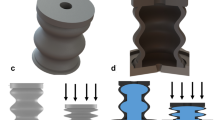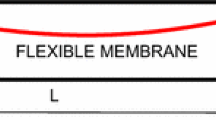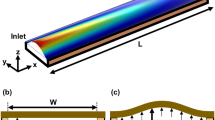Abstract
For several decades, there has been a strong research interest in microfluidic systems and their applications. To bring these systems to market, a high development effort is often necessary for conceptualization and fabrication of such systems as well as the implementation of automated biological analysis processes. In this context, the simulation of microfluidic processes and entire microfluidic networks is becoming increasingly important, as this allows a significant reduction in development efforts, as well as easy adaptation of existing systems to specific requirements. This work presents an analytical model for elastomeric membrane-based micropumps as well as guidelines on how to apply this model to calculate microfluidic networks. The model is derived from the Young–Laplace equation for a non-prestressed elastomeric membrane with a purely nonlinear deflection as a function of applied pressure. The resulting cubic pressure–volume relation is validated by static measurements of the membrane deflection and the transported volume. The model is further used to calculate transient volume flows induced by a membrane micropump in a microfluidic network by adding Hagen Poiseuille’s law. Pressure measurements in the pump chamber confirm the basic assumptions of the model and allow definition of its validity scope. This work lays the foundation for designing elastomeric membrane-based micropumps together with microfluidic networks, estimating maximum flow rates in the system and optimizing pum** frequencies for different microfluidic configurations.









Similar content being viewed by others
References
Akers A, Gassman M, Smith R (2006) Hydraulic power system analysis. CRC Press. https://doi.org/10.1201/9781420014587
Au SH, Edd J, Stoddard AE, Wong KHK, Fachin F, Maheswaran S, Haber DA, Stott SL, Kapur R, Toner M (2017) Microfluidic isolation of circulating tumor cell clusters by size and asymmetry. Sci Rep. https://doi.org/10.1038/s41598-017-01150-3
Banejad A, Passandideh-Fard M, Niknam H, Hosseini MJM, Shaegh SAM (2020) Design, fabrication and experimental characterization of whole-thermoplastic microvalves and micropumps having micromilled liquid channels of rectangular and half-elliptical cross-sections. Sensors Actuators A: Phys 301:111713. https://doi.org/10.1016/j.sna.2019.111713
Bardaweel HK, Bardaweel SK (2013) Dynamic simulation of thermopneumatic micropumps for biomedical applications. Microsyst Technol 19(12):2017–2024. https://doi.org/10.1007/s00542-012-1734-3
Berg J, Anderson R, Anaya M, Lahlouh B, Holtz M, Dallas T (2003) A two-stage discrete peristaltic micropump. Sensors and Actuators A: Phys 104(1):6–10. https://doi.org/10.1016/s0924-4247(02)00434-x
Bott H, Leonhardt R, Laermer F, Hoffmann J (2021) Employing fluorescence analysis for real-time determination of the volume displacement of a pneumatically driven diaphragm micropump. J MicromechMicroeng 31(7):075003. https://doi.org/10.1088/1361-6439/ac00c9
Bronstein IN, Semendjajew KA (1991) Taschenbuch der mathematik, 25th edn. Teubner Verlagsgesellschaft, Nauka-Verlag, Leipzig, Moskau, B. G
Brooks DE (1984) The biorheology of tumor cells. Biorheology 21(1–2):85–91. https://doi.org/10.3233/BIR-1984-211-213
Bui G, Wang JH, Lin JL (2017) Optimization of micropump performance utilizing a single membrane with an active check valve. Micromachines 9(1):1. https://doi.org/10.3390/mi9010001
Cheung LSL, Zheng X, Wang L, Baygents JC, Guzman R, Schroeder JA, Heimark RL, Zohar Y (2011) Adhesion dynamics of circulating tumor cells under shear flow in a bio-functionalized microchannel. J Micromech Microeng 21(5):054033. https://doi.org/10.1088/0960-1317/21/5/054033
Chia BT, Liao HH, Yang YJ (2011) A novel thermo-pneumatic peristaltic micropump with low temperature elevation on working fluid. Sensors and Actuators A: Phys 165(1):86–93. https://doi.org/10.1016/j.sna.2010.02.018
Choi S, Lee MG, Park JK (2010) Microfluidic parallel circuit for measurement of hydraulic resistance. Biomicrofluidics 4(3):034110. https://doi.org/10.1063/1.3486609
Dinhof P (2001) Untersuchungen zur beeinflussung der scherempfindlichkeit von CHO-Zellen durch lipoide und cyclodextrine in proteinfreiem Medium. PhD thesis, Universität Hannover. https://doi.org/10.15488/5802
Grover WH, Skelley AM, Liu CN, Lagally ET, Mathies RA (2003) Monolithic membrane valves and diaphragm pumps for practical large-scale integration into glass microfluidic devices. Sensors and Actuators B: Chem 89(3):315–323. https://doi.org/10.1016/s0925-4005(02)00468-9
Guevara-Pantoja PE, Jiménez-Valdés RJ, García-Cordero JL, Caballero-Robledo GA (2018) Pressure-actuated monolithic acrylic microfluidic valves and pumps. Lab Chip 18(4):662–669. https://doi.org/10.1039/c7lc01337j
Henning A (2003) Improved gas flow model for microvalves, vol. 2. pp 1550 – 1553. https://doi.org/10.1109/SENSOR.2003.1217074
Henning A (2006) Comprehensive model for thermopneumatic actuators and microvalves. J Microelectromech Syst 15:1308–1318. https://doi.org/10.1109/JMEMS.2006.879665
Jenke C, Kager S, Richter M, Kutter C (2018) Flow rate influencing effects of micropumps. Sensors Actuators A: Phys 276:335–345. https://doi.org/10.1016/j.sna.2018.04.025
Jeong OC, Park SW, Yang SS (2005) Fabrication and drive test of a peristaltic thermopnumatic PDMS micropump. J Mech Sci Technol 19(2):649–654. https://doi.org/10.1007/bf02916186
Johnson D, Borkholder D (2016) Towards an implantable, low flow micropump that uses no power in the blocked-flow state. Micromachines 7(6):99. https://doi.org/10.3390/mi7060099
Laplace P (1805) Traité de Mécanique Céeste, vol 4. Courcier, Paris, France
Laser DJ, Santiago JG (2004) A review of micropumps. J Micromech Microeng 14(6):R35–R64. https://doi.org/10.1088/0960-1317/14/6/r01
Mazloum J, Shamsi A (2020) 3d design and numerical simulation of a check-valve micropump for lab-on-a-chip applications. J Micro-Bio Robot 16(2):237–248. https://doi.org/10.1007/s12213-020-00139-y
Meng E, Wang XQ, Mak H, Tai YC (2000) A check-valved silicone diaphragm pump. In: Proceedings IEEE Thirteenth Annual International Conference on Micro Electro Mechanical Systems (Cat. No.00CH36308), IEEE. https://doi.org/10.1109/memsys.2000.838491
Mohith S, Karanth PN, Kulkarni S (2019) Recent trends in mechanical micropumps and their applications: a review. Mechatronics 60:34–55. https://doi.org/10.1016/j.mechatronics.2019.04.009
Nguyen NT, Wereley S (2006) Fundamentals and applications of microfluidics, (integrated microsystems), vol 1, 2nd edn. Artech House, Norwood, Massachusetts, USA
Ni J, Li B, Yang J (2012) A pneumatic PDMS micropump with in-plane check valves for disposable microfluidic systems. Microelectron Eng 99:28–32. https://doi.org/10.1016/j.mee.2012.04.002
Oh KW, Lee K, Ahn B, Furlani EP (2012) Design of pressure-driven microfluidic networks using electric circuit analogy. Lab Chip 12:515–545. https://doi.org/10.1039/C2LC20799K
Oosterbroek R, Lammerink T, Berenschot J, Krijnen G, Elwenspoek M, van den Berg A (1999) A micromachined pressure/flow-sensor. Sensors Actuators A: Phys 77(3):167–177. https://doi.org/10.1016/s0924-4247(99)00188-0
Pergal MV, Nestorov J, Tovilović G, Ostojić S, Gođevac D, Vasiljević-Radović D, Djonlagić J (2014) Structure and properties of thermoplastic polyurethanes based on poly(dimethylsiloxane): Assessment of biocompatibility. J Biomed Mater Res 102A:3951–3964. https://doi.org/10.1002/jbm.a.35071
Piccin E, Coltro WKT, da Silva JAF, Neto SC, Mazo LH, Carrilho E (2007) Polyurethane from biosource as a new material for fabrication of microfluidic devices by rapid prototy**. J Chromatogr A 1173(1–2):151–158. https://doi.org/10.1016/j.chroma.2007.09.081
Podbiel D, Boecking L, Bott H, Kassel J, Czurratis D, Laermer F, Zengerle R, Hoffmann J (2020) From CAD to microfluidic chip within one day: rapid prototy** of lab-on-chip cartridges using generic polymer parts. J Micromech Microeng. https://doi.org/10.1088/1361-6439/aba5dd
Poiseuille JLM (1846) Recherches expérimentales sur le mouvement des liquides dans les tubes de très petits diamètres. Mémoires présentés par divers savants à l’Académie royale des sciences de l’Institut de France, Paris, IX:433–544
Pourmand A, Shaegh SAM, Ghavifekr HB, Aghdam EN, Dokmeci MR, Khademhosseini A, Zhang YS (2018) Fabrication of whole-thermoplastic normally closed microvalve, micro check valve, and micropump. Sensors Actuators B: Chem 262:625–636. https://doi.org/10.1016/j.snb.2017.12.132
Richter M, Linnemann R, Woias P (1998) Robust design of gas and liquid micropumps. Sensors Actuators A: Phys 68(1–3):480–486. https://doi.org/10.1016/s0924-4247(98)00053-3
Rupp J, Schmidt M, Muench S, Cavalar M, Steller U, Steigert J, Stumber M, Dorrer C, Rothacher P, Zengerle R, Daub M (2012) Rapid microarray processing using a disposable hybridization chamber with an integrated micropump. Lab Chip 12:1384. https://doi.org/10.1039/C2LC21110F
Salmanzadeh A, Sano MB, Shafiee H, Stremler MA, Davalos RV(2012) Isolation of rare cancer cells from blood cells using dielectrophoresis. In: 2012 Annual International Conference of the IEEE Engineering in Medicine and Biology Society. IEEE. https://doi.org/10.1109/embc.2012.6346000
Schwarz I, Zehnle S, Hutzenlaub T, Zengerle R, Paust N (2016) System-level network simulation for robust centrifugal-microfluidic lab-on-a-chip systems. Lab Chip 16:1873. https://doi.org/10.1039/C5LC01525A
Shaegh SAM, Wang Z, Ng SH, Wu R, Nguyen HT, Chan LCZ, Toh AGG, Wang Z (2015) Plug-and-play microvalve and micropump for rapid integration with microfluidic chips. Microfluid Nanofluidics 19(3):557–564. https://doi.org/10.1007/s10404-015-1582-4
Shaegh SAM, Pourmand A, Nabavinia M, Avci H, Tamayol A, Mostafalu P, Ghavifekr HB, Aghdam EN, Dokmeci MR, Khademhosseini A, Zhang YS (2018) Rapid prototy** of whole-thermoplastic microfluidics with built-in microvalves using laser ablation and thermal fusion bonding. Sensors Actuators B: Chem 255:100–109. https://doi.org/10.1016/j.snb.2017.07.138
Sim WY, Yoon HJ, Jeong OC, Yang SS (2003) A phase-change type micropump with aluminum flap valves. J Micromech Microeng 13(2):286–294. https://doi.org/10.1088/0960-1317/13/2/317
Smits JG (1990) Piezoelectric micropump with three valves working peristaltically. Sensors Actuators A: Phys 21(1–3):203–206. https://doi.org/10.1016/0924-4247(90)85039-7
Sprague I, Kay JL, Bragd MS, Battrell CF (2020) Low elasticity films for microfluidic use. US Patent App. 16/679,076
Tsukinovsky D, Zaretsky E, Rutkevich I (1997) Material behavior in plane polyurethane-polyurethane impact with velocities from 10 to 400 m/sec. J Phys IV Colloq. https://doi.org/10.1051/jp4:1997359
Tuantranont A, Mamanee W, Lomas T, Porntheerapat N, Afzulpurkar NV, Wisitsoraat A (2007) A three-stage thermopneumatic peristaltic micropump for PDMS-based micro/nanofluidic systems. In: 2007 7th IEEE Conference on Nanotechnology (IEEE NANO), IEEE. https://doi.org/10.1109/nano.2007.4601399
Unger MA, Chou HP, Thorsen T, Scherer A, Quake SR (2000) Monolithic microfabricated valves and pumps by multilayer soft lithography. Science 288(5463):113–116. https://doi.org/10.1126/science.288.5463.113
van Lintel HTG, van De Pol FCM, Bouwstra S (1988) A piezoelectric micropump based on micromachining of silicon. Sensors Actuators 15(2):153–167. https://doi.org/10.1016/0250-6874(88)87005-7
Woias P (2005) Micropumps—past, progress and future prospects. Sensors Actuators B: Chem 105(1):28–38. https://doi.org/10.1016/s0925-4005(04)00108-x
Wu WI, Sask KN, Brash JL, Selvaganapathy PR (2012) Polyurethane-based microfluidic devices for blood contacting applications. Lab Chip 12(5):960. https://doi.org/10.1039/c2lc21075d
Wu CH, Chen CW, Kuo LS, Chen PH (2014) A novel approach to measure the hydraulic capacitance of a microfluidic membrane pump. Adv Mater Sci Eng 2014:1–8. https://doi.org/10.1155/2014/198620
Yang YJ, Liao HH (2009) Development and characterization of thermopneumatic peristaltic micropumps. J Micromech Microeng. https://doi.org/10.1088/0960-1317/19/2/025003
Yoon H, Sim WY, Yang S (2001) The fabrication and test of a phase-change micropump. American Society of Mechanical Engineers. Micro-Electromech Syst Div Publ (MEMS) 3:479–484
Yoon SH, Reyes-Ortiz V, Kim KH, Seo YH, Mofrad MRK (2010) Analysis of circular PDMS microballoons with ultralarge deflection for MEMS design. J Microelectromech Syst 19(4):854–864. https://doi.org/10.1109/jmems.2010.2049984
Young WC, Budynas RG (2002) Roark’s formulas for stress and strain, 7th edn. McGraw-Hill, New York
Young T (1805) An essay on the cohesion of fluids. Philos Trans Royal Soc London III 95:65–87. https://doi.org/10.1098/rstl.1805.0005
Zengerle R, Richter M (1994) Simulation of microfluid systems. J Micromech Microeng 4(4):192–204. https://doi.org/10.1088/0960-1317/4/4/004
Acknowledgements
The authors are grateful to Juergen Willing for performing the standardized tensile test measurements. The authors thank Roland Zengerle for the discussions on derivation of the model and Bernd Scheufele for proofreading the manuscript.
Author information
Authors and Affiliations
Corresponding author
Additional information
Publisher's Note
Springer Nature remains neutral with regard to jurisdictional claims in published maps and institutional affiliations.
Appendix
Appendix
Numerical simulation to estimate the error resulting from the assumptions for the analytical model. The simulation was set up in COMSOL, computing the displacement of an elastic membrane securely clamped with the form of the investigated pump chamber and displaced through a surface load. As the pump chamber is symmetrical in x and y direction, two symmetry planes were inserted into the model to reduce computing times. The pressure in the COMSOL experiment is given in arbitrary units, as the elastic modulus taken for the membrane in the simulation was estimated and deviates from the actual value. So the membrane displacement as a function of the applied pressure is shown qualitatively but not quantitatively. First, the pressure is determined when the membrane reaches the limit stop which is at 0.6 mm (height of the pump chamber from the zero line of the membrane). The displacement of the center point of the membrane is shown in the graph as a function of pressure. The positions of the membrane at the pressure steps \(p=0\) (zero line of the membrane) and \(p=0.14\) (just before the membrane reaches the maximum displacement) are also displayed
Two different simulation experiments compared (I) the pressure-dependent displacement of the membrane with a limit stop in the dimensions of the pump chamber (upper row and darker curve) with (II) the pressure-dependent displacement of the membrane without a limit stop (lower row and light curve). The displaced volume was extracted for every simulated pressure step and is shown in the displayed graph. The position of the displaced membrane is shown for the pressure steps \(p=0\), \(p=0.14\), \(p=1\) for simulation (I) and for the pressure steps \(p=0.14\), \(p=0.4\), \(p=1\) for simulation (II). The displaced volume for simulation (I) at \(p=0.14\) is the same as the displaced volume for simulation (II) at \(p=0.14\) which is \(V_\text {pumped}={2.785}{\upmu }L\). After \(p=0.14\), when the membrane center reaches the maximum displacement, the two curves start to deviate from each other as the increasing contact area between membrane and pump chamber results in an increasing counterforce and limits the maximal displaceable volume to 3.75 \(\upmu\)L (corresponding to \(\frac{1}{8}\) of the pump chamber volume for the simulated part of the pump chamber with two symmetry planes and displacement of the membrane from the zero line)
Cross-section of the pump chamber and graphical visualization of the residual volume in the pump chamber at different positions of the displaced TPU-membrane: The pressure-driven displacement of the TPU-membrane was simulated with the same model as described in Fig. 10. For a pressure \(p=0\) the membrane is in its zero position, meaning that 50 % of the pump chamber volume is already pumped out, if the membrane started from its maximum position, being displaced by negative pressure. The membrane is being displaced through applied overpressure, while its center reaches the half of the maximum displacement position from the zero line at \(p=0.04\) and its maximum displacement position at \(p=0.14\). From here the rest of the membrane area is displaced further until every point reaches its maximum displacement position, which would be when the membrane is fully clinging to the pump chamber. The pumped fluid volume as well as the fluid volume that is still in the pump chamber is displayed in the table at \(p=0\), \(p=0.04\), \(p=0.14\) and \(p=0.3\). As the model contains two symmetry planes and the displaced volume is computed from the zero line of the membrane, the total pumped and remaining volume in a pump chamber is shown in the right columns of the table. The row containing the volumes at the contact point of the membrane center with the pump chamber at \(p=0.14\) is highlighted with a box
Rights and permissions
About this article
Cite this article
Bott, H., Dörr, A., Hoffmann, J. et al. Analytical model describing the nonlinear behavior of an elastomeric pump membrane in a microfluidic network. Microfluid Nanofluid 26, 40 (2022). https://doi.org/10.1007/s10404-022-02545-z
Received:
Accepted:
Published:
DOI: https://doi.org/10.1007/s10404-022-02545-z







